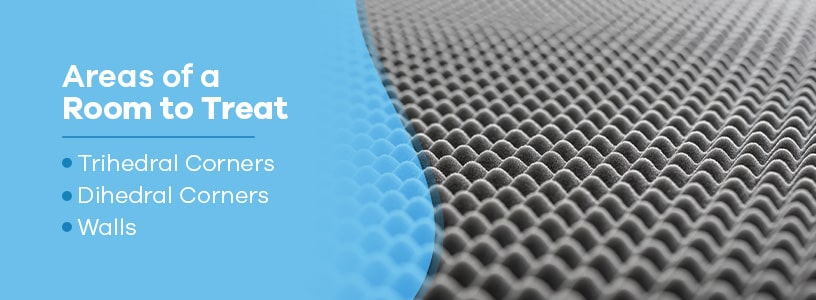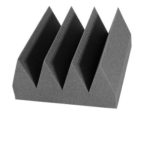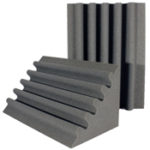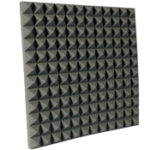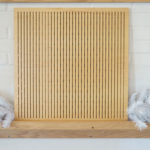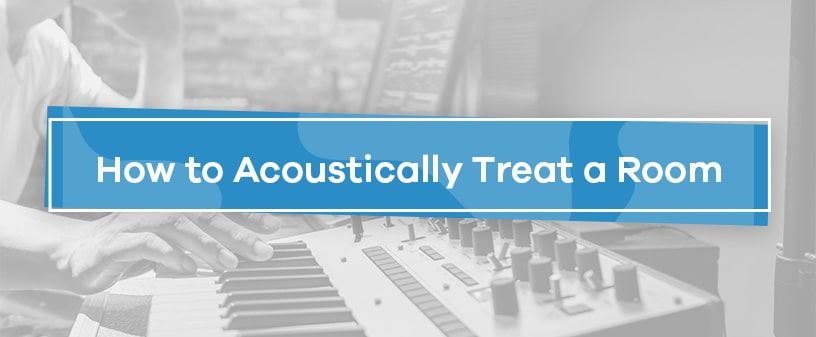
Table of Contents:
What Is Acoustic Treatment
Why Acoustic Treat Rooms
Areas of a Room to Treat
Materials to Acoustically Treat Rooms
Sound quality is integral to a successful recording session in a recording studio. The acoustics of a room play a huge part in how well your microphone captures your sound, which then impacts your ability to manipulate and edit the sound later.
Acoustic treatment improves sound quality in a room through strategically using bass traps, acoustic foam and acoustic panels. Learning how to properly acoustically treat a room with acoustic treatments can seem complicated, but anyone can do it! In this guide to acoustic treatment, we’ll go over everything you need to know to get the best sound quality for your space.
What Is Acoustic Treatment?
Acoustic treatment sounds like an excellent idea for a home recording studio, so what exactly is it? Essentially, acoustic treatment is the process of improving a room’s acoustics, whether it’s for a small recording studio, an auditorium or anything in between.
Acoustic treatment most often uses acoustic foam, acoustic panels and bass traps. While these can all be different sizes and impact different frequencies, they all have the same job of absorbing sound. Acoustic foam prevents unwanted sound waves from bouncing back to your microphone.
Sometimes, especially in bigger rooms, diffusers are also used in acoustic treatment. Diffusers are typically made of wood or plastic, and though they might seem counterproductive to use alongside sound absorbers, they also play a part in good acoustics. Diffusers help break up sounds, reducing echo but still allowing the full sound to exist.
Why Should You Acoustically Treat a Room?
Unfortunately, a quality microphone, while necessary, will only get you so far. If the acoustics of your recording studio are not quite right, your recording will still sound slightly off. That’s where acoustic treatment comes in.
Acoustic treatment is essential both for recording and mixing. When you’re recording, sound waves bounce off the walls and ceiling, often coming back to be picked up by the microphone. This is known as reverb, and while reverb can be a meaningful element of recording, it’s better to control it rather than simply accepting the reverb of the room you’re in.
Because of reverb, your voice and music recordings all have the qualities of the space they were recorded in. The sound quality of your bedroom or garage is not ideal for a professional recording. Home acoustic treatment can improve that sound quality, giving you a better recording.
Overall, acoustic treatment is not meant to eliminate reverb. Rather, it allows you to control it.
Acoustic treatment is also helpful while mixing. If you’re mixing your sound in a small room with no acoustic treatment, the room will affect what you hear.
If you’ve controlled and balanced the room, you can make more informed choices about your sound recording. Acoustic room treatment allows you to capture a better sound that is easier to mix, giving higher quality results.
Areas to Consider When Acoustically Treating a Room
Now that you know why acoustics are so important, let’s get into how to acoustically treat a room. There are three different areas of the room that you should treat, including trihedral corners, dihedral corners and walls.
Let’s take a look at each one.
1. Trihedral Corners
Trihedral corners are where three surfaces meet — the junction between two walls touching the floor or the ceiling. Trihedral corners can have huge impacts on the acoustics of your room because they are the intersection of three different planes.
If you’re working on a budget, you should prioritize getting sound absorbers into the trihedral corners.
2. Dihedral Corners
Dihedral corners are where two surfaces meet. This could be two walls, a wall and the ceiling or a wall and the floor. While not as impactful as trihedral corners, dihedral corners still deal with two different dimensions. Covering these should be your next priority in determining how to sound treat a room for acoustics.
3. Walls
It might be surprising that walls are in last place. They are still important, but you don’t typically need to cover them entirely. When you’ve got a plan that covers both trihedral and dihedral corners and the walls, then you have a solid starting point for acoustic treatment!
Materials to Acoustically Treat a Room
When you’re finally ready to treat your recording studio acoustically, you need to assemble your materials. Here are some of our picks for the best sound absorption materials for room sound treatment.
1. Bass Traps
Bass traps are essential to sound treating a room. Low-frequency sound waves are long and powerful, making them difficult to trap. Bass traps are specially designed for absorbing these low-frequency waves and are very effective for acoustic treatment.
Because of their importance, you should place bass traps in the corner of your space. Bass traps are sometimes called corner traps because of their placement.
For high-quality bass traps that will absorb those low-frequency sounds, look no further than Soundproof Cow’s Udderly Quiet® Corner Traps. These bass traps can work as freestanding corner traps or as mounted, permanent fixtures. Either way, placing our bass traps in the corners of your studio will ensure the best acoustics for your space.
2. Acoustic Foam
Acoustic foam panels are what people think of first when they think of acoustic treatment. Because these foam panels cover more surface area and are generally thinner than bass traps, they are better to get more wall coverage for less money.
Sound waves bounce between opposite parallel walls, making acoustic foam the perfect way to help prevent this. When mounting acoustic foam panels, you’ll want to stagger their arrangement on the wall, like a checkerboard.
For best results, make sure you arrange the foam panels opposite the parallel walls. You should place both walls in a checkerboard pattern. Directly across from each foam panel should be a blank area. This will help you get maximum coverage for your studio area.
Soundproof Cow’s Udderly Quiet® Pyramid Acoustic Foam is perfect for any of your acoustic foam needs. Our acoustic foams are made from high-quality, professional-grade foam and maximize sound absorption with their pyramid shape.
3. Acoustic Panels
Even once you have your walls and corners covered, sometimes you also need to treat your ceiling. Because of their large size, acoustic panels are perfect for acoustically treating your ceiling. You can either hang them from or mount them on your ceiling, and they’ll get right to work on absorbing sound.
At Soundproof Cow, our EccoTone™ Acoustic Wood Panels are specially crafted for optimal sound absorption and diffusion. You can even request a customized pattern for your wood panels for those who want to build a studio with style!
Purchase Soundproofing Materials From Soundproof Cow
With Soundproof Cow’s high-quality soundproofing acoustic materials, you can optimize and control the sound in your studio in no time. We’ve highlighted some of the best materials you can use to treat your studio acoustically, but if you want more options, you can browse our entire shop online. If you have any further questions, feel free to contact us today!



